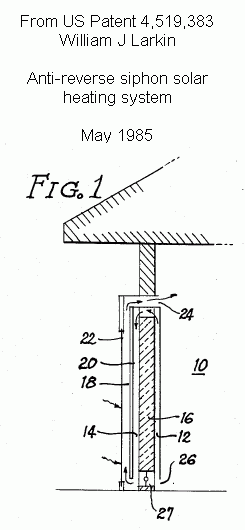 The
essence of the invention is shown in FIG. 1. In order for the heater to
work properly, there need be a fluid mass, which in FIG. 1 is the air
in the room 10, and a fluid flow passageway comprises an ascending
passageway 12 which loops over into a descending passageway 14 which is
separated from the ascending passageway by means of an insulator 16,
which in the embodiment of FIG. 1 takes the form of an insulated wall.
At the bottom of the descending passageway, the continuous passageway
flows into a heating chamber 18 in which the fluid is warmed by means
of heating element 20. In this embodiment, the heating element is a
flat plate absorber, which defines the heating chamber together with
glazing 22.
The
essence of the invention is shown in FIG. 1. In order for the heater to
work properly, there need be a fluid mass, which in FIG. 1 is the air
in the room 10, and a fluid flow passageway comprises an ascending
passageway 12 which loops over into a descending passageway 14 which is
separated from the ascending passageway by means of an insulator 16,
which in the embodiment of FIG. 1 takes the form of an insulated wall.
At the bottom of the descending passageway, the continuous passageway
flows into a heating chamber 18 in which the fluid is warmed by means
of heating element 20. In this embodiment, the heating element is a
flat plate absorber, which defines the heating chamber together with
glazing 22. As the sun passes through the glazing and into the absorber, air in the heating chamber 18 expands and circulates out through the upper outlet 24 while drawing fresh air into the inlet 26.
At night, the absorber will dissipate heat through the glazing and become the coldest part of the system. The heating chamber 18 will become a cooling chamber, and as the density of air in the heating chamber increases, it will develop a pressure head and try to move downward. Ordinarily, if the bottom of the heating chamber entered directly into the room, there would be a constant, steady flow of cold air back into the room, while hot air would be drawn out of the room at the top through what was supposed to be the warm air outlet 24. With this system, however, as the cold air moves downwardly and forces warmer air up the descending passageway 14, because of the insulation 16, cold air fills the descending passageway as well as the heating chamber, equalizing the pressure head. Backflow is thus eliminated.
It is not always desirable to prevent backflow. When it is cool outside and the house is hot, backflow would be desirable. Or, if the unit faces north, it could effectively be made to backflow even in the daytime through use of the butterfly valve 27. As illustrated in FIGS. 2 and 3, when this valve is open, the anti-reverse-siphon feature is completely negated and reverse siphoning takes place as though the loop had not been incorporated in the first place.